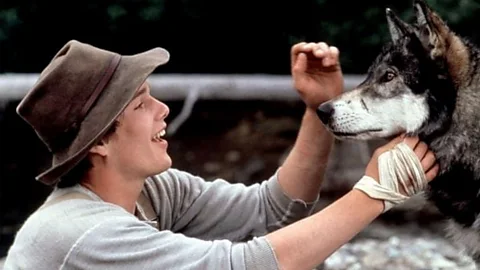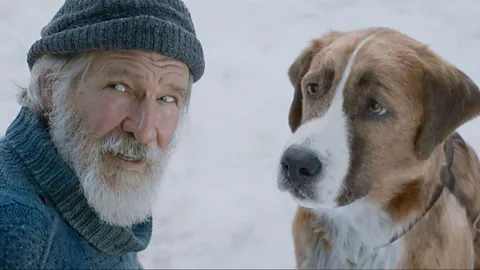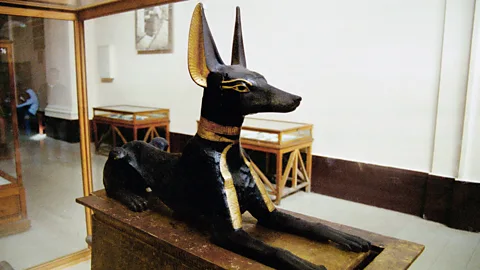The timeless appeal of one-man-and-his-dog stories
 Alamy
AlamyThirty years on, Disney's take on White Fang remains a classic example of a story as old as time – where men are made vulnerable by a trusty canine, writes Hanna Flint.
In the 1991 film adaptation of Jack London’s classic novel White Fang, there's a scene where Ethan Hawke's Jack Conroy, a city boy trying to strike it rich in the Klondike Gold Rush of 1896, inadvertently causes the sled being pulled by the dogs of his guides to topple over. He's brought too many books with him on the journey to Yukon Valley and the weight has offset the balance of the transport.
More like this:
Unfortunately, the sled is also carrying the body of Dutch, a fallen comrade of Jack's guides, who had promised to bury his body at a specific place in the Alaskan wilderness. As it careens down a snowy bank, Dutch's coffin bursts open and the dead man's body falls out. It transpires that he wasn't being laid to rest on his own – his arms are wrapped tightly around the body of his dead dog.
 Alamy
AlamyIt's a simple, throwaway shot – but one that speaks volumes about the bond between human and canine that is the core subject of the Disney live-action feature, directed by Randal Kleiser (best known for Grease). Thirty years on from its original release, White Fang is as much of an intrepid classic of the one-man-and-his-dog sub-genre as the original novel. Sure, in the cold light of 2021 it might seems somewhat cheesy and earnest – and unlike London's book, it prioritises the perspective of the man over its titular dog to its detriment. But there's still something so reassuringly plucky and entertaining about seeing this live action wolf-dog in action alongside Hawke, before he shrugged off the studio jacket in favour of more independent fare.
It was certainly a career milestone for the actor, who credits the film for setting him on the path to success. "It was the single best experience of my acting life," Hawke maintained in 2015. "If I could teach an acting class now, I would have people work with half-breed wolves. I went out there for six weeks, where I had no job except to hang out with these half-breed wolves. I would walk them in the morning and feed them and get to know them, so that our interaction would be authentic.
"That's one of the reasons why I think people talk about the value of rehearsal," he added. "Simply being together with people qualifies as rehearsal. The more you spend time and understand each other's eccentricities, like with these animals."
When it comes to this particular kind of buddy movie, Disney has certainly cornered the market. A quick search on its Disney+ streaming service brings up several films that were released before White Fang and also focus on the companionship of a man or boy and his mutt, including Old Yeller (1957), Greyfriars Bobby (1961), The Biscuit Eater (1972) and Turner & Hooch (1989). There have been multiple screen adaptations of London's 1903 novel Call of the Wild: last year, the studio released another starring Harrison Ford, while in December 2019 it served up a new and original addition to the sub-genre, Togo, starring Willem Dafoe. Meanwhile, other recent non-Disney human-dog/wolf adventures have included the 2018 releases Alpha (on Sony Pictures) and a French animated version of White Fang (on Netflix). The latter marks the 12th time London's book has been adapted into a film since 1925, with the range of versions produced by different countries in different languages a sure sign of the story's timeless and global appeal.
In the majority of these films, the canine protagonist has a strong connection to the wilderness, whether they be a wolf-dog mix, a dog embracing its wild heritage, a sled dog facing wild terrains or an actual wolf in the Ice Age. An innate connection is shown between animal and nature, which in turn often provides the foundation for the bond between dog and man.
 Alamy
AlamyThat's not to say there haven't been one-woman-and-her-dog offerings over the years. Toto is the constant companion to Dorothy Gale in L Frank Baum's Oz novel series and its various film and musical adaptations, while the famous little orphan Annie also has a trusty canine sidekick called Sandy in Harold Gray's 1924 comic strip and her other incarnations. More adult studies of the bond between woman and dog have included the 2017 film Megan Leavey, about a Marine and her combat dog, and Sigrid Nunez's 2018 novel The Friend.
But nevertheless, women have been relatively marginalised in this type of story, which more frequently focuses on a bond that revolves around heroism and masculinity, as well as the expression of male vulnerability.
Stories of domestication
In the case of the 1991 White Fang film, the central relationship is between Jack, an amalgamation of several characters from the novel, and the eponymous wolf-dog, who take turns saving one another. White Fang prevents Jack from being attacked by a grizzly bear; Jack then rescues White Fang from being used by illegal dogfighters, and later, after being nursed back to health and tamed, the mutt repays the favour by protecting his master from being gunned down by the same criminals. This scene is echoed by a fight sequence in the more recent Call of the Wild adaptation in which Buck, a St Bernard–Scotch Collie mix, kills the attacker of his latest human companion Thornton (Ford) by pushing him into a burning cabin in the Yukon Valley. In fact, the original White Fang novel was written after the success of Call of the Wild in 1903 as a mirror to London's debut, which explored the return of the domesticated dog back to its wild nature.
"I have the idea for the next book I shall write... not a sequel to Call of the Wild. But a companion to [it]," London said in a letter to George P Brett. "I'm going to reverse the process. Instead of the devolution or decivilization of a dog, I'm going to give the evolution, the civilization of a dog – development of domesticity, faithfulness, love, morality, and all the amenities and virtues."
London looked at the brutality of nature and man through the eyes of his eponymous half-breed wolf, who is raised by his mother until they are taken in by an indigenous tribe and separated. Having to fend for himself much of the time, White Fang becomes harsh and solitary and then even more feral when he is sold to a dog fighter. It is only when a rich young man (in the book, called Weedon Scott) saves him from this life and gives him the warmth, love and patience to learn a tamer way of being that the wolf-dog finds peace and purpose by man's side.
White Fang's approach, with its emphasis on the domestication of dogs, certainly fits more with the literary tradition of the man and dog trope, which existed long before London was penning his adventure tales. In fact, most ancient cultures commemorated humans' affinity with dogs as not just hunters but faithful companions. In Egypt, dogs were highly valued by families and are referenced in stone carvings made in the Predynastic Period (circa 6000-3150 BCE) and in images and texts created circa 3500-3200 BCE, during the Gerzean Culture. The god Anubis had the head of a dog and Egyptians believed he guided souls to the Hall of Truth to be judged by the god Osiris. The deified warrior Erlang Shen is a famous mythological figure in Chinese history and is frequently depicted as being aided in battle by Xiàotiān quǎn, his faithful "Howling Celestial Dog". The mythical canine even plays a small part in Wu Cheng'en's popular 16th Century novel Journey to the West by helping his master to subdue Sun Wukong, the Monkey King.
 Alamy
AlamyIn Homer's The Odyssey, meanwhile, written circa 8th Century BCE, Argos is the loyal dog of tragic hero Odysseus who was a great hunter known for his strength and speed. During his master's absence of two decades, the once "wild beast" has been neglected – but has survived for one sole purpose. "As soon as he saw Odysseus standing there, he dropped his ears and wagged his tail, but he could not get close up to his master," Homer writes. "When Odysseus saw the dog on the other side of the yard, dashed a tear from his eyes... Argos ed into the darkness of death, now that he had fulfilled his destiny of faith and seen his master once more after 20 years."
How they critique masculinity
In the epic poem, Odysseus often shows his tearful emotions, but thousands of years later authors like Fred Gipson used the man and dog paradigm to comment on and critique the societal conventions of masculinity that pushed for men and boys to suppress their feelings. In his 1956 coming-of-age novel Old Yeller, adapted by Disney several times, his young protagonist Travis Coates is consciously unemotional in order to prove his manliness. "I wasn't about to cry," he says when his father leaves for what will be months on a cattle drive. "I was 14 years old, pretty near a grown man. I stood back and didn't let on for a minute that I wanted to cry." However he then bonds with Old Yeller, who protects his family twice from wild animals, only to be forced to kill the dog when he contracts rabies. The experience is traumatising for the boy but come the film's end, he is able to process that grief by laughing and crying at the sight of his brother bonding with one of Yeller's offspring.
Again and again, in these stories, while dogs are domesticated, men open up. Tom Flynn, the screenwriter of Togo, tells BBC Culture that men "are trained to bury those emotions so you don't cry" and believes that in showing quintessentially masculine men connecting with their vulnerability, one-man-and-and-his-dog movies offer a positive flipside to the whole cultural conversation over toxic masculinity. However, at the same time, he argues that for many characters in these stories – like his lead Leonhard Seppala (Dafoe), a musher (or dog sled driver) who has to navigate life-threatening conditions – their emoting has to have limits. "You think about Alaska in the 1920s, or in a lot of these movies where we place this type of guy, they have to turn it off," he says. "Seppala's got a business to run. He can't take chances and he can't get sentimental about these things because it's life and death."
Togo tells the true story of this Norwegian man-of-the-wild and his titular Siberian husky, who became local heroes in Alaska in 1925 after taking part in a dog sled relay across 674 miles (1,085 km) of snow and ice in severe weather to collect a vaccine during a diphtheria outbreak. Early on in Togo's life, Seppala writes him off as a weak pup but the underdog soon proves himself as a speedy, natural-born leader of the pack. Even in old age, Togo's heroism and courage are relied upon to complete the vaccine run. But as the brutal work takes its toll on the old dog, Seppala's stoicism begins to crumble and his emotions bubble to the surface. His show of vulnerability wasn't a bit of Disney sentimentality added to the script, however – it was true to the real bond between these partners. "When Seppala was close to ing away, he said, 'There is not one day that goes by, where I do not think of Togo fondly. There's not one day I do not think of him with sadness that he's gone'," says Flynn. "In the film, Seppala is super reluctant to show [emotion] but Togo brings it back to the surface. That's why [the scene] in which he [finally] allows the dog [into his] bed at the end is so great. It's why these movies work so well. The dogs bring [emotion] back out."
 Alamy
AlamyThe final scene of the 1991 White Fang adaptation sees Jack return to the cabin in the woods and reunite with his wolf-dog companion. Having struck gold, he had previously sent White Fang away so that he could return to the city, but his bond with the animal as well as the wilderness calls him back. The camera cuts romantically back and forth between Jack and the canine as the music swells and they run towards each other. White Fang launches himself into his human's arms and they fall to the ground. A crane shot follows them sprinting across a vast field of grass and pulls back to reveal the beauty of the great outdoors that together they will roam free. This is not how the book ends – in London's telling, White Fang is taken to California and becomes fully domesticated. But the film leaves the audience with the promise of more adventures – and that's what they got in 1994 with the release of White Fang 2: Myth of the White Wolf.
Now even more man and dog stories are expected onscreen. Channing Tatum has co-directed Dog, in which he stars as an army ranger who takes his Belgian Malinois companion Lulu on a road trip to a funeral. Meanwhile Disney, of course, will be adding another to their collection with a Turner & Hooch remake, this time a 12-part series starring Josh Peck. Clearly, for as long as dogs are considered man's best friend, that age-old bond will be eulogised on screen. "I firmly believe that you're right about that," says Flynn. "Our connection to dogs makes our lives better. These movies are in our DNA."
Love film? BBC Culture Film Club on Facebook, a community for film fanatics all over the world.
If you would like to comment on this story or anything else you have seen on BBC Culture, head over to our Facebook page or message us on Twitter.
And if you liked this story, sign up for the weekly bbc.com features newsletter, called The Essential List. A handpicked selection of stories from BBC Future, Culture, Worklife and Travel, delivered to your inbox every Friday.
